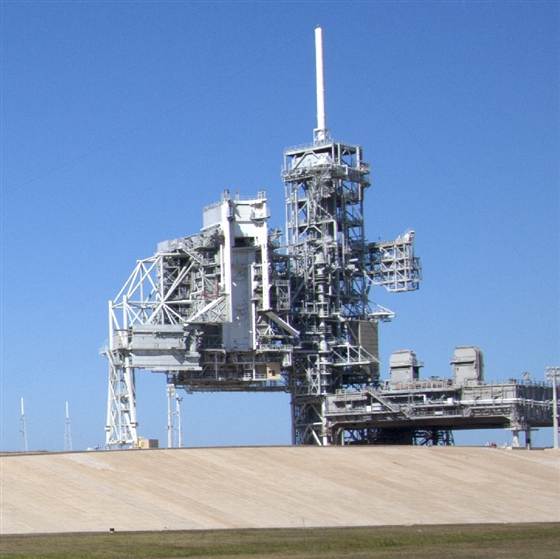The Government Accountability Office on Thursday rejected a protest from the Blue Origin space venture that has been holding back action on NASA’s plan to hand over control of its historic Launch Complex 39A to a commercial operator.
The decision is a setback for Blue Origin, which is backed by Amazon’s founder, Jeff Bezos — and it’s a positive sign for SpaceX, the rocket company founded by tech titan Elon Musk.
On one level, the tug of war over Pad 39A at NASA’s Kennedy Space Center in Florida has been portrayed as a battle of the billionaires. On another level, it’s a battle over how NASA’s surplus space resources will be used in the wake of the shuttle fleet’s retirement and the space agency’s shift toward commercialization.
“Given today’s GAO ruling, NASA is looking forward in the near future to selecting an industry partner for negotiations to lease and operate LC-39A,” the agency said in a statement issued after Thursday’s ruling. “Permitting use of this valuable national asset by commercial entities will ensure its continued viability and will allow for its continued use in support of U.S. space activities.”
NASA announced no firm timetable for handing over the launch pad.
Blue Origin vs. SpaceX
NASA says it no longer needs Pad 39A, which had served as the launch site for Apollo moon missions as well as space shuttle flights. In May, it solicited proposals for outside ventures to manage the facility, which would save the space agency an estimated $100,000 a month in maintenance costs. NASA would retain control of Kennedy Space Center’s other pad, 39B, for development of its own Space Launch System.
Blue Origin and SpaceX both put in bids to use Pad 39A for commercial space missions. SpaceX proposed using Pad 39A exclusively for its own orbital launches. Blue Origin, in contrast, proposed running the pad as a multi-user facility while it prepares for its own orbital operations starting in 2018.
In July, NASA Administrator Charles Bolden hinted that the agency was closing in on a deal, and that it could involve one company’s exclusive use of Pad 39A. He said Pad 39B could accommodate the needs of multiple users as well as NASA’s own needs. That sparked an initial protest from Blue Origin: The company said that it read NASA’s original solicitation as favoring a multi-user arrangement for Pad 39A, and that Bolden’s comments contradicted that interpretation.
NASA denied Blue Origin’s initial protest, telling the company that Bolden’s comments would have no effect or influence on the selection process. But in September, Blue Origin took its protest to the GAO, which considers disputes relating to federal government contracts.
NASA’s process cleared
The GAO had until Thursday to render its ruling. In a 12-page decision, general counsel Susan Poling said NASA’s procedure dealt even-handedly with the choice between exclusive use and a multi-user arrangement for Pad 39A.
“The approaches are different — and require the presentation of different information to substantiate the plan being offered — but there currently is nothing in the record beyond the protester’s arguments to show that either approach necessarily is better in terms of meeting the agency’s objective of achieving the fullest commercial use of space,” she wrote.
The GAO decision doesn’t directly affect whether Blue Origin or SpaceX will get the pad — but if the watchdog agency had sided with Blue Origin, that would have been a blow to SpaceX’s ambitions. If NASA really is closing in on a deal, SpaceX is the likelier suitor.
In a September email exchange with the weekly Space News, Musk suggested that Blue Origin’s protest might have been a “phony blocking tactic,” conducted in concert with United Launch Alliance, SpaceX’s biggest rival in the U.S. launch industry.
“If they do somehow show up in the next 5 years with a vehicle qualified to NASA’s human rating standards that can dock with the Space Station, which is what Pad 39A is meant to do, we will gladly accommodate their needs,” Musk wrote. “Frankly, I think we are more likely to discover unicorns dancing in the flame duct.”
Neither SpaceX nor Blue Origin commented on Thursday’s decision. Here’s the full NASA statement, attributed to spokesman Allard Beutel:
On Dec. 12, 2013, the U.S. Government Accountability Office (GAO) notified NASA that it had denied a protest filed against the Agency by Blue Origin LLC on Sept. 13, 2013. In its protest, Blue Origin raised concerns about the competitive process NASA was using to try to secure a potential commercial partner(s) to lease and maintain the Agency’s Launch Complex (LC) 39-A at Kennedy Space Center in Florida. Blue Origin had argued that the language in the “Announcement for Proposals” (AFP) favored one proposed use of LC-39A over others. The GAO disagreed.
“The GAO’s ruling is posted on the GAO website: http://www.gao.gov/products/B-408823
“Given today’s GAO ruling, NASA is looking forward in the near future to selecting an industry partner for negotiations to lease and operate LC-39A. Permitting use of this valuable national asset by commercial entities will ensure its continued viability and will allow for its continued use in support of U.S. space activities.
“The reuse of LC-39A is part of NASA’s work to transform the Kennedy Space Center into a 21st-century launch complex capable of supporting both government and commercial users. Kennedy is having success attracting significant private sector interest in its unique facilities. The center is hard at work assembling NASA’s Orion spacecraft and preparing its infrastructure for the Space Launch System rocket, which will launch from LC-39B and take American astronauts into deep space, including an asteroid and Mars.
“In the meantime, in order to maintain the integrity of the LC-39A competition, NASA will not be commenting on or providing additional information about the LC-39A competition beyond the publicly-released, May 23, 2013 Announcement for Proposals until an agency selection related to LC-39A is made and announced publicly by the agency.
By: Alex Boyle
To view the original article CLICK HERE


